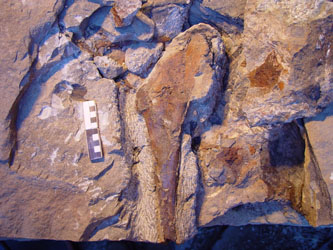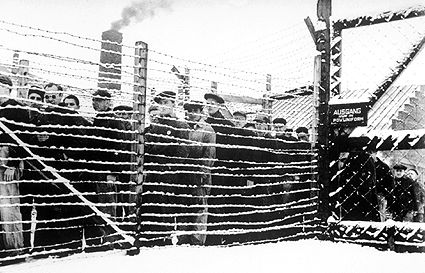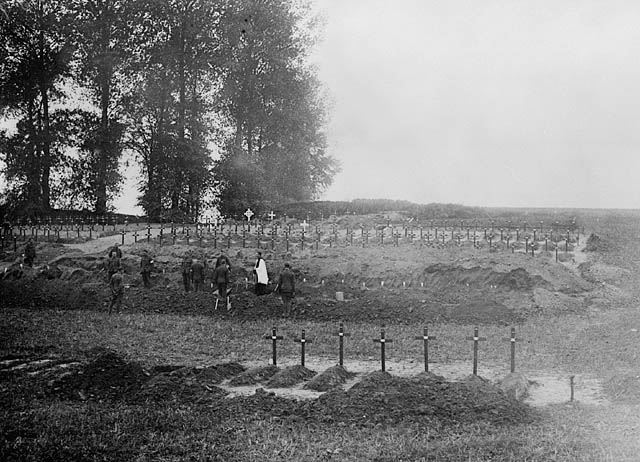How do you get from the Dinosaurs to Beaumont-Hamel?
In this round of six degrees of Canadian history, we begin with “tyrant lizards” in a land before time and end at a village in Belgium. The Battle of Beaumont-Hamel, the first day of the Somme offensive
, was a perilous one for Newfoundlanders, who suffered great losses in one of the bloodiest conflicts of the First World War
.
Connecting dinosaurs and humans — two species separated by 65 million years of evolution. What could possibly go wrong?
The following article is from our Six Degrees of Canadian History series. Past series are not updated.
Dinosaurs

Dinosaur (derived from the Greek deinos sauros, meaning "awe-inspiring lizard”) is a term used for a taxonomic group of animals that dominated Earth during the Mesozoic era, between 250 and 65 million years ago. Dinosaurs evolved from the same ancestral stock as pterosaurs (flying reptiles) and crocodiles, and are almost certainly the direct ancestors of birds. From their first appearance early in the Mesozoic, they rapidly evolved into many different forms, and competed so successfully with mammal-like reptiles that they became the dominant land animals.
The rich dinosaur beds of southern Alberta were discovered in 1884 by geologist, explorer and historian Joseph Tyrrell.
Joseph Tyrrell

While working for the Geological Survey of Canada (1881–98), Joseph Tyrrell explored the vast areas of western and northern Canada, consolidating information gathered by earlier explorers and filling in blank spots on the maps, especially in the North-West Territories. The Royal Tyrrell Museum of Palaeontology provides an impressive monument to Tyrrell’s discoveries in palaeontology — Tyrell notably uncovered the first Albertosaurus skull ever found. The museum is in Drumheller, Alberta, near Dinosaur Provincial Park, where many of its specimens were unearthed.
Provincial parks, such as Dinosaur, were created in response to growing concerns about the depletion of natural resources and the degradation of scenic places in the late 19th century. Canada’s national parks were founded for similar reasons, including Banff National Park.
Banff National Park

Banff National Park (established 1885, 6,641 km2) is Canada's first and most visited national park. Its eastern gate is located approximately 100 km west of Calgary in the Rocky Mountains. The park stretches 240 km along the eastern slope of the Continental Divide, with Jasper National Park at its northern boundary. Originally set aside to preserve sulphur hot springs for public use, Banff's towering mountain peaks, emerald green lakes and flower-strewn meadows make it one of Canada's most exhilarating holiday areas.
However, one of the park’s darker secrets is that many of its roads and infrastructure projects were built by interned Canadians during the First World War.
Internment

Internment defines the detention or confinement of a person in time of war. In Canada, such persons were denied certain legal rights, notably freedom from unlawful detention — though in certain cases they had the right to appeal their custody. Even if they were not strictly prisoners of war (POWs), civilian internees were generally treated according to international POW standards, enduring hunger and forced labour. Of 8,579 men interned at 24 camps across Canada during the First World War, 5,954 were of Austro-Hungarian origin, including 5,000 Ukrainians. Another 2,009 were German, 205 were Turkish and 99 were Bulgarian.
The director of internment operations in Canada during the First World War was Major General Sir William Otter.
Battle of Beaumont-Hamel

On 1 July 1916, Allied forces launched a major offensive in France during the First World War. The opening of the Somme offensive turned into one of the deadliest days in the history of modern warfare. At the village of Beaumont-Hamel, the First Newfoundland Regiment suffered catastrophic losses. After a battle lasting only 30 minutes, less than 10 per cent of the regiment was able to answer roll call.

 Share on Facebook
Share on Facebook Share on X
Share on X Share by Email
Share by Email Share on Google Classroom
Share on Google Classroom















